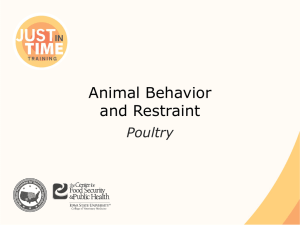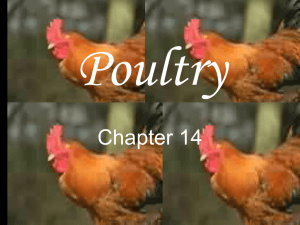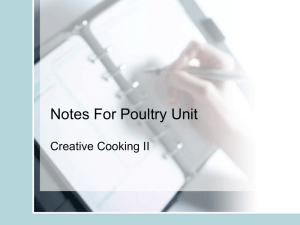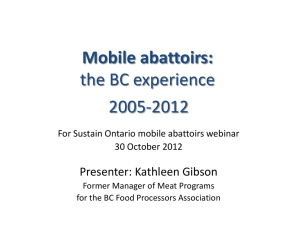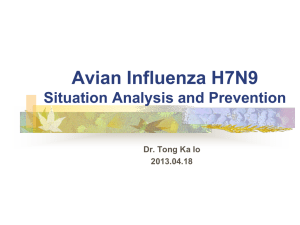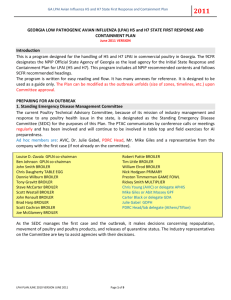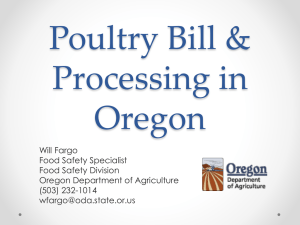Safe Handling
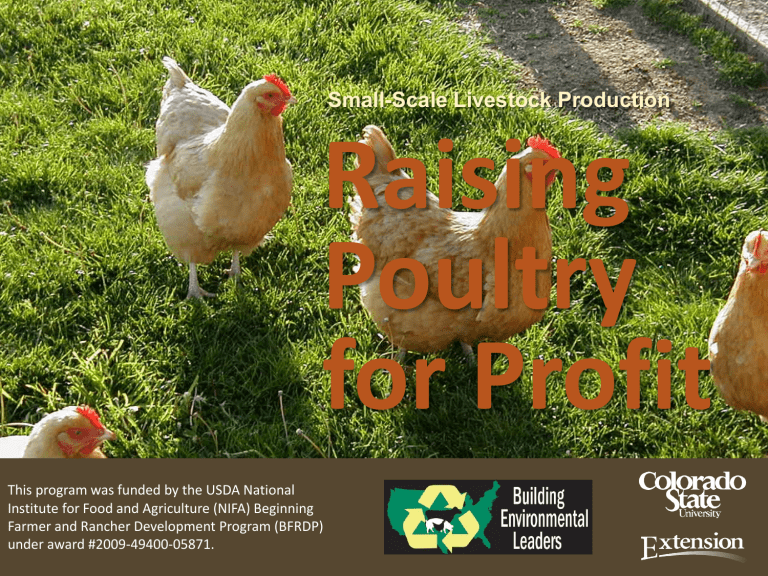
This program was funded by the USDA National
Institute for Food and Agriculture (NIFA) Beginning
Farmer and Rancher Development Program (BFRDP) under award #2009-49400-05871.
Small-Scale Livestock Production
Raising
Poultry for Profit
What you need to know before you get started…
New marketing opportunities
Environmental stewardship
Production practices
Safe product handling
Business licensing
Zoning restrictions
New Marketing Opportunities
• Leveraging flock management
• Certification programs
• Evaluating program costs & benefits
Certification and Marketing
• Consumers are interested in how livestock are raised, handled & processed
• Certification may allow you to secure a premium for product or expand market reach
– Such as specialty food stores and restaurants that require that their animal products be sourced from humanely raised animals
• How you manage your flock (your stewardship practices) can influence your marketing opportunities
Animal Welfare Certification
Programs
• Distinguish livestock products as coming from humanely treated animals
• Certified production systems often are more expensive than non-certified
• Be sure to keep in mind the production costs and marketing benefits of following a certification program
Animal
Welfare
Approved
USDA
Organic
American
Humane
Certified
Food
Alliance
Global
Animal
Partnership
United
Egg
Producers
Possible Program Specifications for Flock Management
Outdoor access
Sleep period requirement
Litter management & ammonia levels
Space allowances
(roosting & range)
Catching birds for transport
Evaluating Certification Programs
Goals • Make sure program goals align with yours
Certification
• Understand the certification process & animals covered
Fees • Understand the program’s fee structure
Time Commitment
Production Costs
• Calculate the time required to achieve & maintain certification
• Estimate how your production costs may change under certification
Evaluating Certification Benefits
Access to new markets that seek certified products
Possibility of charging higher prices for products
Ability to connect with customers based on their values
Access to marketing materials and support from certifying organization
Certifier may help grower improve safe production and handling techniques
Evaluating Certification Costs
More ranging or living area may be required for each bird enrolled in the certification program You may need more land
Changes to poultry health care You may need to remove from your program sick birds that you vaccinate or medically treat
Changes to poultry feeding You may need to use feed from specific sources or follow certain ingredient guidelines
Changes to poultry housing You may need to build additional facilities to allow more space per bird
More detailed record-keeping on poultry health and raising
You may need to allow more time or hire someone to do this
Linking Production & Marketing
Decisions
• Choose a breed that is appropriate for the products you want to produce (meat vs eggs)
• If you are producing meat animals, do you have a slaughter and processing facility that will work with your level of production?
• Know who will buy your product before you produce it
• Take a course in Good Agricultural Practices (GAPs)
– To understand how to prevent or reduce contamination of your products throughout production, processing and sales
– Obtaining GAPs certification is also a good marketing strategy
Environmental Stewardship
To be a good neighbor and food producer:
• Manage manure properly
• Monitor storm water runoff
• Dispose of mortalities safely
Good Stewardship Leads to
Better Business Management
Minimizing:
•Animal and manure odors
•Dust
•Insects & predators
Using best management practices to:
•Dispose of dead birds
•Mitigate runoff
Leads to a:
•Cleaner production operation
•Healthier herd
•Good neighbor relationships
Manage Manure Properly
Control unpleasant odors and dust
Know the nutrient content of your manure, apply based on nutrient/fertilizer value, and keep records
Spread manure away from wells, springs, and watercourses
When possible, till in fall-applied manure
Keep piles of manure, spent bedding and spoiled feed away from watercourses
Monitor Storm Water Runoff
Conduct annual tests for bacteria and nitrates in well water
Locate poultry operations away from wellheads; protect wellheads in pastures (consult local/state wellhead protection laws)
Use buffers and setbacks to protect surface waters from direct contact with animal waste and process waste water
Divert clean water (run-on) around production and waste storage areas using berms, ditches grassy swales, roof gutters
Dispose of Dead Birds Safely
Abide by state/local laws
Render within 48 hours, where service is available (dead animals used to create a new, usable product)
Compost in pile or bin, at high temperature (130 o -150 o F)
Bury on farm, at least 300 feet away from a watercourse and 3-ft deep, above the wet season high watertable
Bury/dispose at a licensed landfill
Production Practices
• Maintaining a healthy flock
• Managing sick birds
• Growing your flock
Animal Welfare
Preventing disease among your flock involves good stewardship and management
Managing for Healthy Birds
Includes Providing
Adequate space & ventilation
Clean housing & bedding material
Access to water at all times
Nutritionally complete food
Protection from predators
Protection from extreme temperatures
Managing Sick Birds Includes
• Having a local avian veterinarian who understands your flock management program
• Establishing a plan for:
– Any unknown disease
– Avian Influenza & Exotic Newcastle (cause significant morbidity in flocks)
• In case of disease outbreak, having a plan for cleaning and disinfecting vehicles & equipment, and protecting your employees
• Developing a quarantine procedure for sick birds
• Developing a disposal plan for dead birds
Growing Your Flock
• Look for hatcheries participating in Voluntary
National Poultry Improvement Plan (NPIP)
– Certifies that poultry breeding stock and hatcheries are free from certain diseases
• Avoid poultry swaps or other unverified sources
• Quarantine new birds before integrating into your flock
• Keep in mind local regulations for numbers of birds allowable in your area
Safe Handling
• Eggs
• Meat
• Live birds
Eggs: Safe Handling for Small Flocks
Gathering
Washing
Sanitizing
Candling
Drying
Refrigerating
Transporting
• Keep nests clean
• Gather eggs 3 times/day to keep clean
• Use unscented, food-grade detergent + rinse water
• Keep water temperature between 110°F and 120°F
• Dip in 120°F water and bleach at 100-200 ppm chlorine (1oz bleach per 1 gallon water)
• Discard meat spots, blood spots and cracked egg shells
• Dry on racks before putting in cartons
• Store between 33°F and 41°F
• Must be clean
• Maintain refrigeration
Eggs: Safe Handling for Large
Flocks (3,000 or more laying hens)
• Register with FDA under the Egg Rule
• In your facility:
– Buy chicks and young hens only from suppliers who monitor for
Salmonella bacteria
– Establish rodent, pest control, and biosecurity measures to prevent spread of bacteria throughout the farm by people and equipment
– Conduct testing in the poultry house for Salmonella
• Refrigerate: Eggs must be refrigerated at 45° F, within 36 hours of when they are laid
• Pasteurization
• Have a written egg safety plan to prevent foodborne illness outbreaks. See FDA’s new egg rule
Meat: Safe Handling
• Handle all raw poultry carefully to prevent crosscontamination.
• Chill to 40°F or less within a specified time after slaughter.
Keep poultry products cold (40°F or below) or frozen (0°F or below) during transport.
• The term ‘fresh’ may only be placed on poultry that has never been below 26°F.
• Raw poultry held at temperature of 0°F or below must be labeled with a “keep frozen” handling statement.
• Raw poultry has a very short refrigerator shelf life and should be frozen or cooked within two days of purchase.
Live Birds: Safe Handling
• Live baby poultry (chicks, ducklings, gosling and turkey poults) may carry Salmonella
• Bacteria may be in their droppings, feathers, feet, or beaks
• After handling baby poultry:
– Wash your hands thoroughly
• After handling any livestock
– Wash hands thoroughly & change shoes before entering a food production or handling area
Business licensing
Which licenses you need depends on:
– Whether you are selling eggs or meat
– Where you plan to sell your product
– The scale of production you are considering
Getting Permission to do Business
• County, municipal & Homeowners Association or
Neighborhood/Unincorporated Community Covenants
• Business Registration (typically from your state’s Secretary of State, although some cities & counties also require business registration)
• IRS Employer Identification Number (EIN, if you have employees)
• State taxes (sales tax, income tax, workers’ compensation, unemployment insurance)
• City/County sales tax license
• Other business licenses (depending on your sales outlet and product(s) offered for sale)
To check on your state’s tax and licensing requirements:
//www.sba.gov/content/learn-about-your-state-and-local-tax-obligations
How Many Hens Do You
Plan to Have?
< 3000
> =3000
• Flocks under 3000 laying hens are USDA grade exempt and fall under state law
• Flocks of 3000 and over laying hens require business registration with Food Safety
Inspection Service (FSIS) through the FDA
• From place of production?
• Farmers’ market(s)?
• Through retail stores?
Where Do You Plan to
Sell Eggs?
• State licensing can vary depending on where you plan to sell your product
• Licensing may be easier if you plan to sell direct to consumers from your home or place of production
• However, check with the market or retailer for any licenses or food safety audits they may require
Licensing for Retail & Wholesale
Meat Sales
To sell packaged poultry direct to the consumer
• Must use state or federally inspected slaughter and processing facility (see exemption for custom processing)
To sell packaged poultry to retail buyers, wholesale or farmers’ market
• Must use state or federally inspected slaughter and processing facility (see small flock exemption)
• Required: Labeling – i.e., Net Weight using Standard Weights and Measures*
• Optional: Grading
*Note that your processor can help guide you through the packaging and labeling process.
Exemptions to USDA slaughter and processing requirements
Exemption #1 for freezer meats
Sold before slaughter to new owner AND
OR
Labeled
NOT FOR SALE
Processed for household use
AND
Processed for nonpaying guests
Exemptions to USDA slaughter and processing requirements
Exemption #2 for poultry, but not recognized in all states
Producer-grower
1,000 bird per year limit
FOR
Producer-grower
20,000 bird per year limit
FOR
On-farm sales Retail sales
Your County Health Department
May Require
1.
A retail food establishment license for product sales. For example in Colorado:
• Colorado Dept. of Public Health &
Environment Plan Review
• County Health Department Application
2.
3.
4.
• Inspection (possible)
• Estimated fee: $115
• Annual fee, but will be renewed unless revoked
One More Thing About Meat & Egg
Sales…
Many farmers’ markets require vendors to carry their own liability insurance policy
For more info on licensing and regulations check with your local Extension office or state Department of Agriculture
Zoning restrictions
• Zoning is a restriction on the way land can be used
• Zoning regulations may include where you can
(or can’t) raise animals
• Zoning may also define the number of birds you raise on your property
County & Municipal Zoning
Regulations
• Present your plans early―your local planning and zoning board may have ideas to make your business more viable or to protect your resource base
• Once you are in operation, remember to consult local officials before making any changes to your business (to structures or to products you sell)
County & Municipal Zoning
Regulations
• Livestock allowances are usually outlined in land use codes
• Large livestock are typically prohibited in non-agriculturally zoned county or municipal districts
• Many municipalities allow private ownership/production of a small number of fowl, although many exclude roosters and limit the density of confinement
• Your Homeowners’ Association may also have restrictions on poultry
Always verify the number birds legally allowed on your property before starting your business
Regulations in Districts Where Commercial
Poultry Production is Permitted may
Include:
Commercial or agricultural permit requirements
Permit fee often required
Size and type of animal structures; location on your property
Minimum space requirement per chicken; restrictions on roosters
Standards for odor, dust, noise
Limited or no allowable slaughter on premises
Building a Profitable Business
Involves
Building
Customers through
Building
Community through
Building Business
Processes through
Marketing
Safe handling practices
Good resource
& flock stewardship
Good neighbor relations
Research & compliance with regulations and certifications that lead to a sustainable business!
Questions?
Acknowledgments
• Blake Angelo, Colorado State University Extension, Urban
Agriculture
• Dr. Jack Avens, CSU Food Science and Human Nutrition
• Thomas Bass, Montana State University Extension, Livestock
Environment Associate Specialist
• Dr. Marisa Bunning, CSU Food Science and Human Nutrition
• Emily Lockard, CSU Extension, Livestock
• Dea Sloan, CSU Agricultural and Resource Economics
• Martha Sullins, CSU Extension, Agriculture and Business
Management
• Dr. Dawn Thilmany, CSU Agricultural and Resource Economics
• Heather Watts, CSU Agricultural and Resource Economics
• Wendy White, Colorado Department of Agriculture
• David Weiss, CSU Agricultural and Resource Economics
Photo Credits – flickr.com
All photos used under the Creative Commons License
James Bowe
7177637421
Aprilskiver
6351632089


